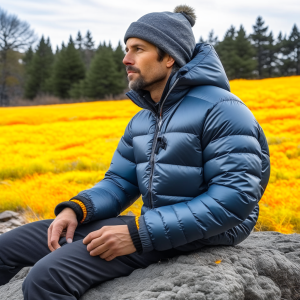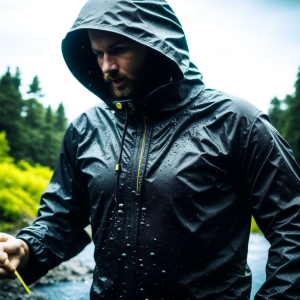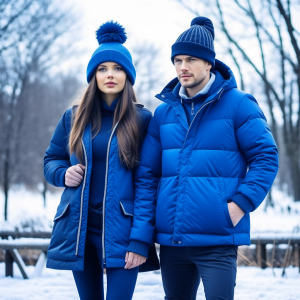Elevate Your Winter Wardrobe with Layered Cold Weather Clothing for Ultimate Warmth and Style
As winter approaches, bringing with it a chilling embrace, the quest for attire that marries warmth with fashion becomes paramount. With temperatures plummeting, you may find yourself layering clothing more than ever. Have you ever pondered the science behind effective layering techniques? In this comprehensive guide, we will dissect the principles of layering, revealing the characteristics that make certain garments more effective in combating the harsh cold. By acquiring this knowledge, you will gain the confidence to remain both comfortable and stylish throughout the winter months, regardless of the weather.
Layering clothing transcends mere fashion; it embodies a strategic approach to optimizing heat retention and overall comfort in frigid environments. When temperatures dip, our bodies instinctively try to maintain heat by constricting blood vessels, often leading to cold extremities. Unfortunately, this biological response can sometimes be inadequate. This is where the tactical application of layering becomes essential, as it allows us to create a robust barrier against the cold while ensuring freedom of movement and comfort in our daily activities.

Crafting Your Base Layer: The Foundation of Winter Warmth and Comfort
The base layer is the cornerstone of your winter wardrobe, meticulously designed to fit snugly against your skin while providing essential insulation. To fully appreciate the significance of this layer, we must explore the complexities of moisture management and its profound impact on your warmth and comfort during the colder months. Understanding these dynamics will empower you to select the most appropriate materials and designs to maximize the effectiveness of your base layer, ensuring a cozy experience even in frigid temperatures.
Maximizing Comfort with Moisture-Wicking Fabrics
Choosing the right fabric for your base layer is crucial for effective moisture management. The importance of moisture-wicking properties cannot be overstated. These specially engineered fabrics excel at pulling moisture away from your skin, whether due to perspiration or external dampness, thereby preventing discomfort and chill. A high-quality base layer acts as a protective moisture barrier, keeping you dry and warm even in the most challenging weather conditions. By ensuring you remain cozy and dry, you significantly enhance your overall warmth and comfort during outdoor activities.
Exploring Insulation: The Advantages of Merino Wool and Synthetic Fabrics
Next, we will delve into how materials such as merino wool and synthetic fibers can significantly enhance the insulating properties of your base layer. Merino wool is renowned for its natural warmth and breathability, making it an exceptional option that provides effective insulation while proficiently wicking moisture away from your skin. Conversely, synthetic materials like polyester and nylon offer an impressive combination of durability and insulation, creating a warm microclimate that retains body heat efficiently, ensuring you remain comfortable even in the harshest conditions.
Achieving the Perfect Fit: Key Considerations for Base Layer Effectiveness
Choosing the right fit for your base layer goes beyond simply opting for your usual size; it’s about optimizing performance to meet your needs. A snug fit ensures constant contact with your skin, which enhances both insulation and moisture-wicking capabilities. However, the right balance is crucial—too tight can restrict movement and comfort, while too loose may compromise effectiveness. Consider your activity level and overall layering strategy to ensure that your base layer integrates seamlessly with your other winter garments, providing the utmost comfort and utility.
In essence, the base layer is not just another item in your wardrobe; it serves as a sophisticated moisture-wicking and insulating shield against the harsh elements of winter. By understanding the unique properties of materials like merino wool and synthetic fibers, as well as mastering the fit, you can transform your base layer from a simple piece of clothing into a vital component of your defense against the cold.
Harnessing the Insulating Layer: Key to Maintaining Body Heat
 As we transition to the insulating layer, it’s crucial to focus on its essential role in capturing and retaining heat close to your body. This layer is vital in the science of heat retention, acting as a protective cocoon against the unforgiving winter elements. We will investigate critical aspects such as warmth-to-weight ratios, the advantages of down insulation, and the eco-friendly benefits of synthetic alternatives, all of which contribute to effective heat management during the coldest months.
As we transition to the insulating layer, it’s crucial to focus on its essential role in capturing and retaining heat close to your body. This layer is vital in the science of heat retention, acting as a protective cocoon against the unforgiving winter elements. We will investigate critical aspects such as warmth-to-weight ratios, the advantages of down insulation, and the eco-friendly benefits of synthetic alternatives, all of which contribute to effective heat management during the coldest months.
Understanding Warmth-to-Weight Ratios for Optimal Insulation
Grasping the concept of warmth-to-weight ratios is essential when selecting an insulating layer. This principle emphasizes that insulation materials should deliver exceptional warmth without unnecessary bulk. Essentially, it’s about maximizing warmth while minimizing weight, allowing for free and comfortable movement. This balance is particularly important for those who desire insulation without feeling constrained, enabling unrestricted activity in cold conditions while ensuring that you stay cozy and protected from the cold.
Down Insulation: Featherlight Warmth for Outdoor Enthusiasts
Down insulation is often the top choice for individuals seeking unparalleled warmth in a lightweight format. Sourced from the soft feathers of ducks and geese, down is celebrated for its remarkable warmth-to-weight ratio, making it an ideal insulation option. Its lightweight and compressible nature suits winter adventurers who require effective warmth without sacrificing mobility. Recognizing the benefits of down insulation is vital to understanding its role in crafting an insulating layer that seamlessly delivers warmth, comfort, and flexibility during outdoor activities.
Choosing Synthetic Insulation: Ethical Warmth for All Conditions
Synthetic insulation materials, primarily derived from polyester fibers, have emerged as popular ethical alternatives within the insulation market. What distinguishes synthetic insulation is its remarkable ability to retain heat even in wet conditions, an area where down insulation may falter. This resilience in unpredictable weather makes synthetic fabrics suitable for various climates. Additionally, opting for synthetic options aligns with ethical considerations, enabling you to experience warmth without compromising your values or environmental concerns.
Precision in Insulation Thickness: Selecting the Right Level of Warmth
Choosing the appropriate thickness for your insulating layer requires careful consideration; precision is key. Assess the anticipated level of cold exposure alongside your layering strategy when determining the thickness of your insulation. In milder climates, a thinner insulating layer may suffice, while harsher conditions may require a thicker, more robust option. By understanding the nuances associated with insulation thickness, you can tailor your insulating layer to meet the specific demands of your winter activities, ensuring optimal comfort and warmth.
Ultimately, the insulating layer goes beyond traditional clothing roles, evolving into a strategic ally in the battle against frigid temperatures. By deciphering the complexities of warmth-to-weight ratios, appreciating the benefits of down insulation and synthetic alternatives, and providing guidance on thickness selection, we can turn the insulating layer into a calculated defense mechanism against winter’s icy grip.
Your Outermost Layer: The Ultimate Barrier Against Winter’s Harsh Conditions
The outermost layer serves as your essential shield against biting winds and frigid temperatures. This crucial layer performs dual functions: it protects against environmental elements while also playing a significant role in moisture management. As we explore the outer layer further, we will uncover the importance of breathability, the transformative effects of DWR finishes and Gore-Tex membranes, as well as the essential windproof features that enhance insulation efficiency, ensuring you remain warm and dry no matter the weather.
Prioritizing Breathability: The Cornerstone of Comfort and Moisture Management
Often underestimated, breathability is a vital characteristic of the outer layer that profoundly impacts overall comfort. This feature pertains to the fabric’s ability to allow sweat vapor to escape from your body while simultaneously blocking external moisture from penetrating. Achieving this delicate balance keeps you dry and comfortable, alleviating the chilling effects of trapped moisture. A breathable outer layer is essential for maintaining a cozy microclimate within your clothing, ensuring exceptional comfort even during inclement weather.
DWR Finishes and Gore-Tex: Leading Waterproofing Technologies
 DWR (Durable Water Repellent) coatings and Gore-Tex membranes represent the pinnacle of cold-weather outerwear technology. DWR finishes provide water-repellent properties to fabrics, creating a formidable barrier against rain, sleet, and snow. Gore-Tex and similar technologies elevate waterproofing by offering an exceptional combination of impermeability and breathability. Understanding how these advanced technologies work together is crucial for staying dry and comfortable, even in the most severe weather conditions.
DWR (Durable Water Repellent) coatings and Gore-Tex membranes represent the pinnacle of cold-weather outerwear technology. DWR finishes provide water-repellent properties to fabrics, creating a formidable barrier against rain, sleet, and snow. Gore-Tex and similar technologies elevate waterproofing by offering an exceptional combination of impermeability and breathability. Understanding how these advanced technologies work together is crucial for staying dry and comfortable, even in the most severe weather conditions.
Windproof Features: Enhancing Your Defense Against Cold Winds
Windproof attributes are indispensable in freezing weather, particularly when biting gusts can penetrate even the sturdiest fabrics. The windproof outer layer acts as an impenetrable barrier against cold air, enhancing comfort while protecting the insulation of the inner layers. By effectively blocking frigid winds, your outer layer becomes a formidable defender, ensuring that your carefully selected layers work in harmony to keep you warm and shielded from the harshest elements.
In essence, the outermost layer is more than just a protective shell; it functions as a sophisticated barrier that expertly balances breathability and waterproofing. By understanding the importance of breathability, exploring the advancements of DWR finishes and Gore-Tex membranes, and recognizing the vital role of windproof features, we can elevate the outer layer into a dynamic garment that excels in style, functionality, and weather resistance, making it a must-have for winter wear.
Practical Tips for Maximizing Warmth and Style This Winter
With a solid understanding of effective layering established, let’s delve into practical tips and strategies designed to elevate your cold-weather experience, seamlessly blending warmth with enduring style. Accessories play a critical role in winter attire, often acting as unsung heroes that can enhance your overall look. From the essential warmth provided by well-chosen gloves to the stylish touch of a cozy hat, and not to mention the comfort of thermal socks, these seemingly minor details significantly contribute to achieving a fashionable and comfortable winter ensemble.
The Essential Role of Accessories: Function Meets Fashion
Accessories are indispensable elements of your defense against the cold, serving functions that extend beyond mere aesthetics. Items such as gloves, hats, and thermal socks not only add visual appeal but are also crucial in enhancing your overall warmth. By thoughtfully integrating these accessories into your winter wardrobe, you can ensure that every part of your body is shielded from the chill, effectively preventing precious body heat from escaping into the icy air and enhancing your overall comfort.
Investing in Quality Accessories: Recommendations for Ultimate Warmth
The pursuit of warmth encompasses not only your base and insulating layers but also the careful selection of accessories. Invest in high-quality gloves crafted from insulating materials like fleece or lined leather to create a robust barrier against the cold. A warm hat, ideally with extra insulation or a cozy faux-fur lining, not only enhances your style but also significantly aids in heat retention. Opt for thermal socks made from merino wool or advanced synthetic blends, ensuring maximum warmth and effective moisture management to keep your feet cozy during winter outings.
Fashion-Forward Strategies: Merging Functionality with Style
Staying warm in frigid temperatures doesn’t necessitate sacrificing your sense of style. Employ savvy styling techniques to navigate the winter landscape with elegance. Experiment with layering various textures in your outfit to create visual interest while simultaneously enhancing insulation. Choose winter-appropriate colors that complement the snowy backdrop, and don’t hesitate to accessorize with vibrant pieces like a bold scarf or fashionable earmuffs, enhancing your overall appearance while showcasing your unique style.
Ultimately, accessories are the understated architects of a well-rounded winter outfit. They not only amplify warmth but also allow you to express your personal style even in the coldest conditions. By selecting high-quality accessories and thoughtfully styling your winter wardrobe, you can conquer the chill while showcasing undeniable elegance and sophistication.
Embrace the Perfect Fusion of Style and Function in Your Winter Attire
As we wrap up our exploration of conquering the cold, it’s essential to recognize the significance of style in winter clothing. Dressing for the cold doesn’t mean sacrificing your fashion sense; instead, the current fashion landscape celebrates the harmonious blend of functionality and flair. Numerous outdoor and fashion brands have acknowledged and embraced the demand for winter gear that not only keeps you warm but also exudes confidence and modern elegance, redefining what it means to dress for winter.
The Evolution of Cold-Weather Clothing: Entering a Stylish New Era
 The cold-weather clothing industry is experiencing a renaissance, where winter gear transcends basic functionality to embody both innovation and style. Designers and brands increasingly recognize the necessity for clothing that seamlessly merges practicality with aesthetic appeal. This shift has ushered in a new era of outerwear that not only provides warmth but also captivates with its visual charm, allowing you to express yourself even in the coldest months.
The cold-weather clothing industry is experiencing a renaissance, where winter gear transcends basic functionality to embody both innovation and style. Designers and brands increasingly recognize the necessity for clothing that seamlessly merges practicality with aesthetic appeal. This shift has ushered in a new era of outerwear that not only provides warmth but also captivates with its visual charm, allowing you to express yourself even in the coldest months.
Leading Brands: Setting the Standard for Style and Function
Several brands are at the forefront of this style evolution, skillfully merging fashion with functionality in their winter apparel. Canada Goose is renowned for its luxurious down coats that deliver extraordinary warmth without sacrificing style. The North Face incorporates cutting-edge technology into its designs, creating outerwear that harmonizes chic aesthetics with practical functionality. Meanwhile, Moncler has redefined the puffer jacket, transforming it into a high-fashion statement piece that showcases the potential for winter clothing to be both functional and runway-ready.
Effective Styling Techniques: Elevate Your Winter Fashion Game
Now, let’s discuss how to effectively blend warmth and style in your winter outfits. Start by selecting standout pieces that fulfill both functional and aesthetic roles, such as a beautifully tailored wool coat or a sleek parka that can serve as the centerpiece of your ensemble. Consider layering a chunky knit sweater over a fitted jacket for a cozy yet fashionable look. Don’t shy away from introducing vibrant colors into your winter wardrobe by accessorizing with striking scarves or trendy boots that make a statement.
Ultimately, embracing style in the cold is no longer a contradiction; it’s a vibrant reality shaped by a dynamic fashion industry. As fashionable cold-weather gear emerges, championed by innovative brands, the narrative shifts from mere survival to personal expression. So, immerse yourself in this style renaissance, select pieces that empower you, and redefine fashion amidst the wintry embrace of the season.
The post Cold Weather Clothing Layers: The Science Explained appeared first on Survival Bite.
The Article Cold Weather Clothing Layers Explained: Understanding the Science Was Found On https://limitsofstrategy.com
The Article Cold Weather Clothing Layers: The Science Behind Them First Appeared ON
: https://ad4sc.com



Comments are closed